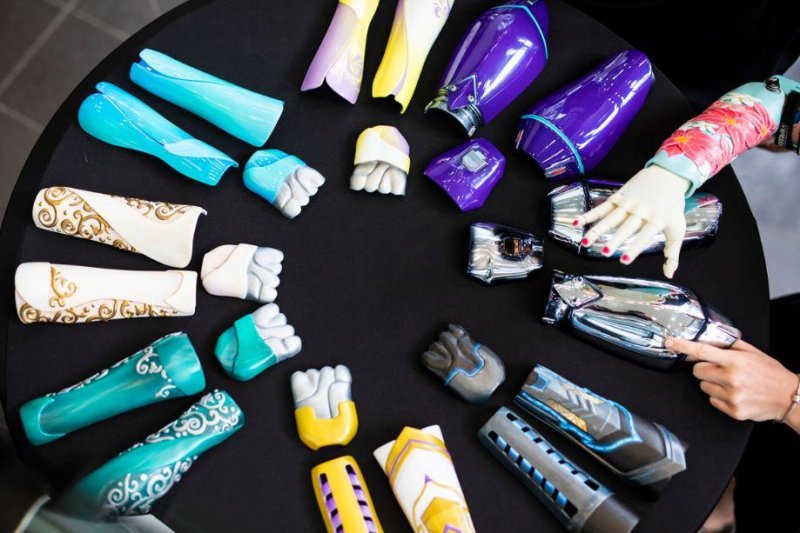Engineers have developed prosthetic arms that are 3D-printed and include changeable covers so that users have more options to personalize their bionic limbs. Photo by Nick Leyva/University of Central Florida
May 16 (UPI) -- For the first time, children will be fitted with 3D-printed bionic arms produced as part of a clinical trial.
Oregon Health & Science University is collaborating with Limbitless Solutions, a nonprofit based at the University of Central Florida, for the trial, which aims to test the limbs for market approval by the U.S. Food and Drug Administration.
The two schools announced Wednesday at a news conference in Orlando that a total of 20 children between age 6 and 17 will be fitted with the devices by the end of this summer at the two schools. The arms will be 3D-printed at UCF for around $1,000 each, compared to ones that traditionally cost up to $100,000 and need to be replaced as children grow.
"This is really like the next level for us," Dr. Albert Manero, CEO of Limbitless Solutions, told UPI. "To bring in a hospital partner and kids to work with really skilled therapists. We will be able to track and evaluate how well the arms are working for the kids."
During the yearlong study, the researchers plan to gather data from 100 users while seeking FDA approval for market clearance, which will enable the devices to be covered by insurance.
"The goal of our project is affordability and accessibility," Albert Chi, an associate professor of surgery at the OHSU School of Medicine, told UPI. "It was my main motivation to even getting involved in 3D printing."
Manero said the 3D arms are structurally similar to traditional ones.
"The $100,000 class of arms might use carbon fiber," he said. "But we have found our arms to be exceptionally strong and resilient."
During the news conference, Limbitless unveiled the third generation of its bionic arms that use multiple motors and smartphone technology.
"We released a new version with more dexterity, with finger movement as well as gestures," Chi said. "To give kids more versatility in the design and aesthetics. There are removable magnetic plates. Kids can make them to be like action heroes."
When children flex their muscles, electromyography records the electrical activity, sending the signals to a computer chip that activates the device.
In 2014, Manero, then a UCF college graduate student in mechanical engineering, and a group of his friends built an arm for a boy at the request of his mother, who they didn't know. The student group then established a nonprofit at UCF that combines engineering, design, art and even video game development.
Actor Robert Downey Jr., who played Tony Stark in Iron Man, helped deliver an action figure-themed arm to 7-year-old Alex Pring. The video of the meeting was a part of Microsoft's Collective Project and has drawn 10.5 million views.
"All of our bionic kids have told a similar story," Manero said in a video produced by the schools to promote the research. "When they would go to a grocery store without an arm, people would come up to them and say 'what is wrong with you, why are you broken."
But it's different with the bionic arm.
"When they are wearing a real expressive, beautiful, artistic arm, the questions completely change," he said. "Instead people come up to them and say 'how does that work. That is so cool. How do I get one for myself.'"
The arms are specially printed for each child.
"It can take days to print on a desktop printer, but with the industrial printers they are a little faster," Chi said. "The lengthy process is because of customization. There is such much pride in each of these arms. It is a labor of love with a lot of TLC to get it to the final product."
Chi, who has served in the U.S. Navy and currently is in the Navy Reserve, has applied practical experience taking care of wounded military personnel.
"I would say it is a very collaborative approach for this project," he said. "Using my experience learned at Johns Hopkins and in the physics lab and in the Navy."
The team is also further developing the technology, including adding sensors to "feel" objects and auditory adaption, and Manero is developing technology to assist paralyzed wheelchair-users using 3D printing.
Arms printed for children in the clinical trial, like those made by the nonprofit at UCF, are free.
Chi said it's a pleasure to apply skills to philanthropic efforts.
"The core of the project is anyone in need gets them for free," he said. "To see children when they get the prosthetic devices is such a moving experience."
Families interested in participating in the prosthetic study can visit 3DHope.com.















